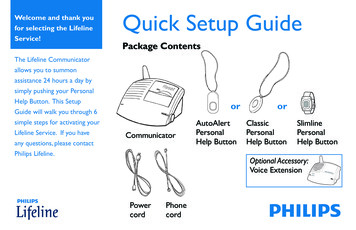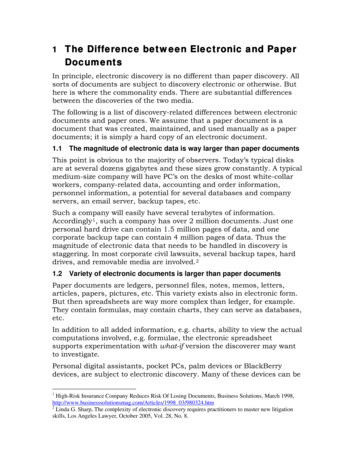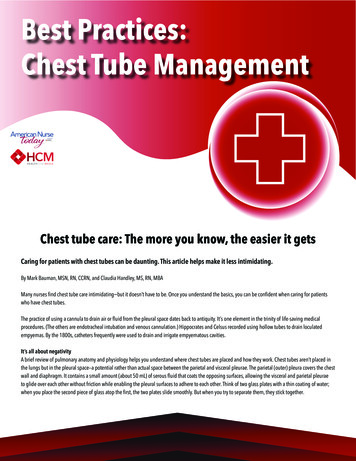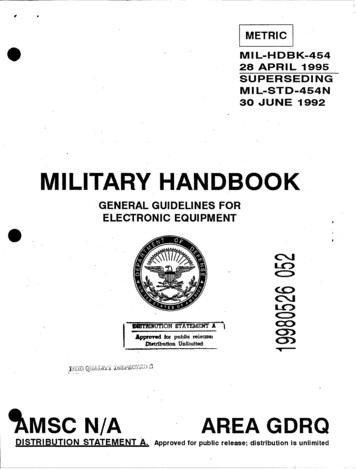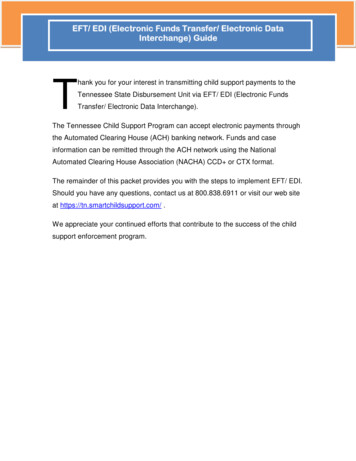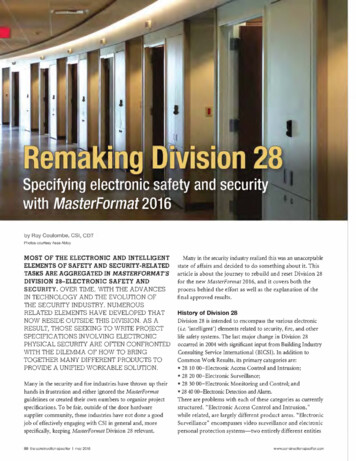
Transcription
Specifying electronic saf,ety and securitywith MasterFormat 2016by Ray Coulombe, CSI, CDTPhotos courtesy Assa AbloyMOST OF THE ELECTRONIC AND INTELLIGENTELEMENTS OF SAFETY AND SECURITY-RELATEDTASKS ARE AGGREGATED IN MASTERFORMAT'SDIVISION 28-ELECTRONIC SAFETY ANDSECURITY. OVER TIME, WITH THE ADVANCESIN TECHNOLOGY AND THE EVOLUTION OFTHE SECURITY INDUSTRY, NUMEROUSRELATED ELEMENTS HAVE DEVELOPED THATNOW RESIDE OUTSIDE THIS DIVISION. AS ARESULT, THOSE SEEKING TO WRITE PROJECTSPECIFICATIONS INVOLVING ELECTRONICPHYSICAL SECURITY ARE OFTEN CONFRONTEDWITH THE DILEMMA OF HOW TO BRINGTOGETHER MANY DIFFERENT PRODUCTS TOPROVIDE A UNIFIED WORKABLE SOLUTION.Many in the security and fire industries have thrown up theirhands in frustration and either ignored the MasterFormatguidelines or created their own numbers to organize projectspecifications. To be fair, outside of the door hardwaresupplier community, these industries have not done a goodjob of effectively engaging with CSI in general and, morespecifically, keeping MasterFormat Division 28 relevant.50 the oanstruclian specifier I may 2016Many in the security industry realized this was an unacceptablestate of affairs and decided to do something about it. Thisarticle is about the journey to rebuild an d reset Division 28for the new MasterFormat 2016, and it covers both theprocess behind the effort as well as the explanation of thefinal approved results.History of Division 28Division 28 is intended to encompass the various electronic(i.e. 'intelligent') elements related to security, fire, and otherlife safety systems. The last major change in Division 28occurred in 2004 with significant input from Building IndustryConsulting Service International (BICSI). In addition toCommon Work Results, its primary categories are: 28 10 00-Electronic Access Control and Intrusion; 28 20 00-Electronic Surveillance; 28 30 00-Electronic Monitoring and Control; and 28 40 00-Electronic Detection and Alarm.There are problems with each of these categories as currentlystructured. "Electronic Access Control and Intrusion,"while related, are largely different product areas. "ElectronicSurveillance" encompasses video surveillance and electronicpersonal protection systems-two entirely different entitieswww.oonstruclionspeoi11 er.earn
that should be categorized as such. Thecurrent breakout of "Electronic Monitoringand Control" is solely dedicated to'detention,' unlike what the title suggests.Even so, detention consultants havefound the related subcategories unsuitablefor their purposes. Finally, "ElectronicDetection and Alann" covers disciplinesrelating to fire detection/alarm, massnotification systems, and environmentalsensors, while the title suggests somethingbroader. Further compounding theseclassification issues are new technologiesintroduced into the security and safetymarkets, and IP networks becoming thepreferred method of communicationsbetween electronic devices.In May 2014, the firm of this article'sauthor, SecuritySpecifiers, approachedthe Security Industry Association (SIA)with a request to jointly engage with CSIto tackle these Division 28 shortcomings.SIA is the voice of the security industry,representing manufacturers, integrators,service providers, and, increasingly,consultants (via a longstanding partnershipwith the International Association ofProfessional Security Consultants [IAPSC]).Further, it is a standards developmentorganization with a history of developingindustry partnerships within and outsidethe security industry.Don Erickson, the association'sCEO, was highly receptive to the idea,and found a willing and enthusiasticaudience in CSI's technical director(and, at the time, interim executivedirector) Greg Ceton. With a series ofconference calls, Ceton and his teamoutlined the process for recommendingchanges to MasterFormat. Given thelikely scope of the effort, CSI requestedrecommendations be submitted intothe approval process by April 2015.An initial group of volunteers to leadportions of the effort was recruited duringJune and July 2014, and an orientationcall was held in August 2014 betweenvolunteers and CSI representatives. Theyidentified 13 product and technologyareas around which to organize thematerial for recommendation. Workingwww.constructlon5poolfier.comgroups for these areas comprised leadersthat represented manufacturers andconsultants alike who had particularexpertise in each area. Over the next twomonths, they were rounded out withadditional volunteers and rough initialcontent was developed. More than 100industry professionals volunteered toassist. Each group labored in earnest,leading to an initial rough draft ofrecommendations presented to CSI inFebruary 2015.At that point, critical guidance wasreceived from CSL A few of theserecommendations (such as establishinga new division for fire-related disciplines)were non-starters. Also, too manytoplevel categories had been identified, andwe were instructed to consolidate andpare those back to allow for futureexpansion. We were also given suggestionsfor the proper format for inputting theanticipated large amount of data.Finally, CSI advised that security-relatedareas outside of Division 28 were fairgame to be addressed.It was decided to use a 'change-matrix'approach to list items to be changed,added, or deleted (and to describe thereason for the change and offer guidancenotes). Frank Pisciotta, then-presidentof IAPSC, supplied a workable format.A next iteration of the changes wasproduced in the required format andoffered to CSI for comment in March2015. Critical feedback led to the thirdand final iteration submitted in April.As this article shows, major changes weregenerated by this effort.Common Work ResultsA significant number of modificationswere made in 28 05 00-Common WorkResults for Electronic Safety and Security.While there is much additional detailcontained under the areas described inthe following paragraphs, the net effectsare to fill in a number of holes, eliminateredundancies, and provide the systemspecifier more flexibility when dealingwith various application-specificelectronic safety and security systems.may 2016 I the construction specifier 51
subsystems. It adds non-surveillance videosections for interrogation, arraignment,and visitation.Other changesPower supplies for security are nowspecifically addressed in Power Sourcesfor Electronic Safety and Security (28 05 07).This recognizes the specialty nature andvoltage range of the low-voltage devicesrequired for electronic security.Photo courtesy AItron ix CorporationNetwork switches and other networkcommunications components are nowincluded In Division 28, where thecommunications system is exclusivelydevoted to the security function. Networkingequipment also appears in Divisions 27and 40.Photo courtesy Phybridge Inc.Detention Security SystemsThe second category, "Detention SecuritySystems," eliminates most of the detention related items in the former categoryof "Electronic Monitoring and Control,"focusing on interfaces to connected-Recommendations were made to addprecast-concrete security bollards underSection 03 48 13 and manufacturedmetal security bollards under 32 39 13.Additional maintenance was performedin detention related items in Divisions08 and 11.Given the extent of the formalrecommendations concerning the areasjust discussed, inputs were provided inthe change-matrix spreadsheet format.One of the challenges in assembling thistool was following the guidance providedby CSI to avoid assigning any suggestedclassification numbers.This task is performed by CSI followingacceptance of recommendations. Therefore,each item added, modified, or deletedwas provided a Reference Number. Ifthe item was new, the new levels andnumbers were reflected to the extentpossible-for example, 28 TBA TBA(i.e. To Be Assigned). Old level numbers(changed or deleted items) were specified.Items were marked as (1) No Change,(2) Add, (3) Modify, or (4) Delete. Adescription of the change, reason for-------change, and recommended GuidanceNotes were provided. Further, a cross reference to MasterFormat 2014 correlatedeach item in the old Division 28 withour corresponding Reference Numberin the new breakdown.CSI evaluators were able to quicklyunderstand the proposed change andhow it fit into the overall framework.This change matrix, the third iterationof the recommendation summary, wassubmitted in April 2015.Explanatory briefings were held in twoconference calls during the summer monthswith CSI's MasterFormatTask Team toexplain the submitted recommendationsand the rationale behind them, as well asthe change matrix's format. There was ageneral awareness and recognitionDivision 28 was due for a major overhaul,and the presentation to the task team waswell-received.It was deemed important the SecurityIndustry Association had agreed to makethis effort a standing ad-hoc committeeto accommodate future changes on atimely basis, serving as a conduit for theindustry's proposed changes to CSL Thiscommittee will consist of a diverse panelof industry experts, serving to representall quarters of the industry concernedwith specified projects.--- I AD IT ONAL IN · RMATIOAuthorRay Coulombe, CSI, CDT, is founder and managing director ofSecuritySpecifiers. He has more than 30 years of experience inthe electronic security industry, and has founded (or been asignificant contributor to) eight startup and early-stagecompanies. In addition to degrees in electrical engineering,management, and information technology Coulombe holdsnumerous industry certifications. He is a Life member of Instituteof Electrical and Electronics Engineers (IEEE), and is also part ofCSI, Tau Beta Pi, and (ASIS). Coulombe is a veteran (captain) ofthe U.S. Air Force, where he participated in the development ofadvanced missile systems. He can be reached via e-mail atray@securityspecifiers.com.AbstractDivision 28 encompasses work results for the electronic and'intelligent' elements related to facility security, fire detection and58 the oaristruclian specifier I may 2016alarms, and other life safety systems. From its intnxluction in 2004 until2014, It experienced very few changes, while the security industryevolved extensively due to both technological innovations and thereallties of the post-9/11 world. This article provides an in-depth on whathas changed in MasterFormat 2016.MasterFormat No.27 00 DO-Communications28 00 DO-Electronic Safety and SecurityUniFormat No.070-Electronic Safety and SecurityKeywordsDivisions 27, 28Access controlElectronic safety and eoi11 er.earn
2014, It experienced very few changes, while the security industry evolved extensively due to both technological innovations and the reallties of the post-9/11 world. This article provides an in-depth on what has changed in MasterFormat 2016. MasterFormat No. 27 00 DO-Communicati

